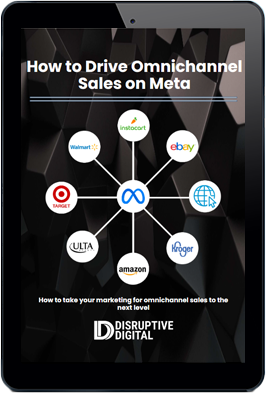This is an excerpt from our ebook, “How to Win International Markets with Meta Ads.”
International expansion, regardless of how significant its benefits might be, doesn’t just happen. It requires a coordinated business effort that touches anything from your website to shipping processes, privacy considerations, payment processes, business licenses, and customer service adjustments. This chapter will cover all six of these considerations in more detail to help you build a consistent stream of cross-border revenue opportunities.
1) Localizing Your Website for International Audiences
Online users might like to shop online, but that doesn’t mean they’re ready for any inconveniences in the process. Localization is the name of the game, which means not just translating some content but ensuring that your online presence and purchase process is just as smooth for the markets into which you’re looking to expand as it would be for your domestic audiences.
That starts with considering the currencies of the markets you’re looking to target. The US Dollar might be the established global business standard, but that doesn’t mean it’s as embraced on the consumer side.
No e-commerce customer wants to do their own math and pay for expensive conversions through their own bank just to make a purchase from your store. That’s why, according to one report, 76% of online shoppers actively look for online stores that price products in their home currency.
This preference means one thing above all: your online store needs to be able to convert prices based specifically on your customers’ locations. Prices, taxes, gift cards, discounts, shipping costs, and even refunds all need to be just as accessible in their home currency as they would be for your local customers.
Fortunately, that process doesn’t need to be manual. Modern website currency converters dynamically change all of these variables based on the location of the user, or allow shoppers to select their preferred currency. Shopify Plus also offers store owners on its platform a multi-currency solution that allows buyers to check out in their preferred currency while merchants still get paid in their local currency.
Don’t forget about pricing nuances, either. Research shows that while prices tend to be more favorably perceived in Western economies when they end in a 9 decimal (like $14.99), the opposite is true in countries like China where consumers prefer a round number (like $15). Understanding how the markets into which you’re expanding react to these pricing strategy can go a long way towards a better, more localized strategy.
FREE GUIDE
How to Drive Omnichannel Sales on Meta
11 Steps + 4 Advanced Tactics to Take Your Marketing for Omnichannel Sales to the Next Level.
What About Localized Website Content?
Currency conversion is a crucial part of your website localization, but it’s not the only consideration. The other is making sure that every piece of your website feels just as normal to international audiences as it would to yor home customer base.
Put differently: international consumers should never even suspect you’re from another part of the world when visiting your online store.
Getting to that point, again, can be complex. It means translating all of your assets, including not just the language but also the visuals and potentially even the color scheme you use. Cultural differences can assign drastically different meaning to these visual and textual signals, so true localization means aligning every part of your online store experience with your audience.
Language translation still matters, of course. Research shows that 76% of consumers prefer shopping online in their native language, while 40% won’t even consider visiting an online store that’s not in their preferred language. Especially in markets that are not similar to your home market, building that more local experience is vital.
Getting your website and online store to that point can take time. We’ve seen the most success with e-tailers who build this out in the experimentation stage, before entering a foreign-language market. Here, you can direct customers to their home country through a landing page, where they’ll choose their region or country before continuing. The alternative is redirecting customers to the relevant store by detecting their browser language or IP address.
Keep in mind, too, that this localization piece extends beyond your website as well. confirmation emails, packing slips, invoices, creative assets, and all other touchpoints between brand and consumer need to be in the right language flow as well.
2) Ensuring Privacy and Data Compliance in International Markets
The United States has relatively light data privacy laws, which can make expanding to international markets more complex for online merchants. Regulation like the European Union’s General Data Protection Regulation (GDPR) are complex, and will require a number of updates and considerations to remain in compliance.
The GDPR specifically protects the individual user’s name, address, email, social media accounts, digital identifying information like their IP address, and any data gleaned from cookies placed on their digital devices. Websites and online store owners who want to be in compliance have to be transparent about the data they collect, and allow users an easy opt-out if desired.
Non-compliance with the GDPR can lead to fines of up to $11 million or 2% of annual revenue, whichever is greater.
The good news: because the GDPR has been in place since 2018, and because it affects such a broad swath of websites and industries, many mechanisms are already in place to automate these protections. Shopify’s extensive documentation on the GDPR is a great place to start, and these features are built into its platform as well.
Through Shopify, e-commerce brands can offer customer transparency and control over their personal data. It also includes technical measures done to ensure that your customers’ personal data is protected, even as it crosses borders for some international shopping.
Of Course, the GDPR is far from the only data privacy law that businesses looking to expand internationally have to consider. You’ll also come across a wide range of privacy laws that can differ widely by country and account for some of the nuances in each market. Familiarizing yourself with them, and ensuring website compliance, is crucial before a true effort to expand into that country’s consumers can succeed.
FREE GUIDE
How to Drive Omnichannel Sales on Meta
11 Steps + 4 Advanced Tactics to Take Your Marketing for Omnichannel Sales to the Next Level.
3) Optimizing Your Shipping Experience for International Customers
The customer experience doesn’t end when they hit the ‘order’ button. The next step is all on you, and it can determine whether a curious one-time customer can turn into an international brand loyalist.
When shipping your products, you’ll need to strike the right balance between speed and affordability. Pricing matters so much that, according to PayPal’s 2022 Borderless Commerce Report, 61% of international consumers are willing and even happy to endure longer shipping times as long as it keeps prices down.
Transparency is key in communicating your shipping options and process. These steps can help you optimize the experience for your customers:
Make Your Delivery Costs and Shipping Times Easy to Find and Understand
On the pages your international customers visit most frequently, as well as during the checkout process, be sure to include this information prominently and clearly:
The countries you’re shipping to
The average length of time required to ship an order to each country
Any free shipping or shipping discount thresholds for individual orders
A dynamic shipping bar can help here, especially after the purchase is complete. Email flows for international customers that inform them about their tracking number and estimated delivery dates can also streamline and ease the process.
Be Clear About Returns from International Customers
Not every customer will like every product they receive from you. It may be damaged during shipping, or just not what they expected. In these cases, returning products should be as easy for your international customers as it is for domestic audiences.
The exact process, of course, might be different. Deadlines or shipping charges may change. The key, again, is to be transparent about these variables to make sure no confusion is introduced for your customers at any point in the process.
Be Transparent About Any Customs, Taxes, or Duties Required
Put yourself in your customers’ position: when you shop for a product online, to you expect to know exactly what you’re paying? The answer is obvious, and it remains true for international audiences. They’re not experts in international commerce law, so they’ll need your help understanding any additional charges they might need to pay to receive your products.
In other words, you have to make the total landed cost clear to all international customers. Failure to do that is one of the biggest mistakes you could make during expansion, leading to lost customers, lower profit margins, and damaged credibility.
Internationally-shipped packages tend to cost more or less based on either their actual weight or volumetric weight. That’s difficult for your customers to calculate, so it’s crucial to be clear about the exact cost your customers will pay to receive their product.
Tax and tariff calculations matter just as much. Get those wrong, and you’ll need to pay extra fees and fines from regulatory authorities, while shipping may be delayed. One way to work around this worst-case scenario is by giving your customers a choice about paying duties when they’re in the checkout process:
Delivery duty paid (DDP), in which you (the merchant) pay all the taxes and fees that apply to your shipment.
Delivery duty unpaid (DDU), in which the customer pays all associated fees and taxes for thes shipment upon delivery.
Giving your customers that choice, and educating them about the implications, means they’re less likely to be surprised by any extra fees that come with their purchase. It also means you don’t have to account for the fines and penalties you might otherwise face, protecting both your profit margins and customer trust in the process.
4) Adjusting Your Payment System for International Markets
We know that customers expect to pay for products in their local currency. But that’s not the end of the story; in addition, they’ll also expect to use the payment system they’re most comfortable and familiar with in the process.
As it turns out, credit or debit cards are not the most popular payment option around the world:
47% of Australian cross-border shoppers prefer PayPal
57% of Brazilian cross-border shoppers prefer credit cards
47% of Chinese cross-border shoppers prefer AliPay
Once you expand that sample beyond cross-border shoppers to include all e-commerce customers, the picture gets even more complicated. In Germany, for example, a bank transfer method called ELV (Elektronisches Lastschriftverfahren) is the most popular payment method, accounting for more than one third of all e-commerce transactions. Credit cards account for just 14%.
And here’s the key: nearly one-quarter, 23% of all consumers, abandon their cart if their preferred payment method is not available.
Put differently, international expansion has to come with a close consideration of the payment methods you offer. Using a global checkout provider is one solution to help capture potential lost customers in international markets.
FREE GUIDE
How to Drive Omnichannel Sales on Meta
11 Steps + 4 Advanced Tactics to Take Your Marketing for Omnichannel Sales to the Next Level.
5) Building an Understanding of Local Market Rules
Europe’s GDPR is just one of the many example of economic and market rules that differ in international territories compared to your home market. A close understanding of these rules is essential to performing business in your expansion territories without running afoul of the local law.
Some countries will require you to apply for and receive an international business license to operate legally, with China among the most prominent examples. Obtaining that license is a comprehensive process, and you might be best off working with a lawyer in the country to follow all the correct steps.
Foreign entities that want to sell in Australia, for example, have to be licensed with the Australian Securities and Investments Commission. Companies like LawPath can help with that process by analyzing company information and recommending appropriate steps. And of course, businesses who want to pursue a physical location in Australia will need additional licenses for the jurisdiction in which they plan to operate.
Other laws get more specific than that. For example, most countries in the European Union require you to register for a value-added tax (VAT) number if your sales are above €35,000 (roughly $37,000 as of December 2022) in that country. If you don’t have an officially registered business in the EU, you can appoint an agent like Corintax Consulting to file VAT returns on your behalf every year.
Following these market rules is essential for strategic business expansion. The occasional random customer from a foreign country will likely not require much action. But once you build a comprehensive plan to attract customers from that country, more steps will be necessary to remain compliant.
6) Developing International Customer Service Channels
As soon as you begin to market and promote your products outside the United States, you need to expect inquiries from the countries to which you’re expanding. That’s especially true considering the various nuances, like tax and shipping information, that international customers have to contend with.
Unless you’re a global brand with a massive customer service operation, it’s likely impossible to manually account for every market you’re looking to unlock. To offer a compelling global customer experience at scale, you need advanced data management practices.
If you’re operating in foreign languages, that means building native-language functionality for your customer support channels.
Consider live chat as one example of that process and optimization. We know that 75% of global consumers prefer live chat over any other channel, largely because the instant answers they’ll receive. But using a multilingual chat service with non-native speakers at the end of the line who rely on translation tools will not be effective. Instead, it will slow down the process and diminish customer satisfaction.
Automated solutions can go a long way towards solving this potential issue. Tools like Gorgias and Zendesk, for example, are purpose-built customer service platforms that allow a relatively easy customer support setup for multiple languages.
To learn more about driving international sales using Meta, check out our ebook here.







